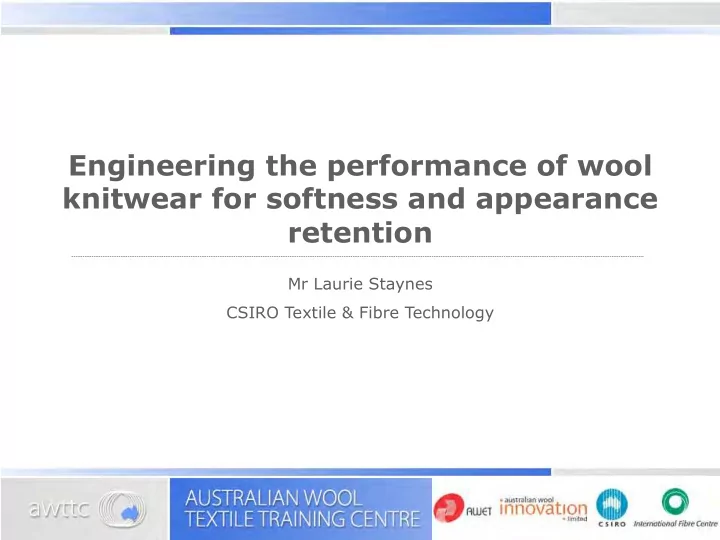

Engineering the performance of wool knitwear for softness and appearance retention Mr Laurie Staynes CSIRO Textile & Fibre Technology
What’s behind the title? § Judicious raw material selection § Suitable processing sequence and conditions § Application of quality and process control measures
What is the result of getting it right? § Superior hand feel and comfort – at point of sale and during wear § Good appearance retention – at point of sale and after wear/laundering § Meeting customer performance expectation – during wear and after laundering
Raw material selection § Fibre diameter and wool quality § Traditionally quoted as a ‘quality number’ given to each lot at sale by an experienced woolclasser § Based on the finest worsted yarn quality capable of being spun from a particular lot of greasy wool § Now measured objectively in microns
Wool quality versus micron Quality value Average micron Super 140s ~16.5 micron Super 120s ~17.5 micron Super 100s ~18.5 micron 80s ~ 19.5 micron 70s ~ 20.5 micron 64s ~ 21.5 micron
Worsted Machine Knitting Yarn Production 30 20 Percentage 10 0 10-12/2 16-18/2 20-22/2 24-26/2 28-30/2 32-36/2 40-42/2 44-48/2 54-60/2 Yarn Count (Nm)
Common micron/two-fold knitting yarn counts Yarn count (Nm) Wool diameter (micron) 2/30s <21.5 2/40s <20.5 2/48s <19.5 2/60 <18.5 2/72 <17.5
Relationship Between Wool Micron & CV% 25 CV% (Fibre Diameter) 24 23 22 21 20 18 20 22 24 26 28 Average Fibre Diameter of Wool Top (micron)
Typical hosiery top profile § Mean Fibre Length (Hauteur) 60-65mm § Coefficient of Variation (Hauteur) 48% § Coefficient of Variation of Diameter 22% § Curvature 90°
Typical Hauteur Diagram (Hosiery Tops) Population Percentage Fibre Length
Typical Hauteur Diagram (Lambswool Tops) Population Percentage Fibre Length
Neps
Worsted spinning
Effect of yarn setting on fabric appearance - cockling
Spirality 80 Tex, Alpha 60, 5° Spirality
Spirality 80 Tex, Alpha 80, 10° Spirality
Spirality 80 Tex, Alpha 100 17° Spirality
Spirality 80 Tex, Alpha 120, 22° Spirality
Typical yarn steaming sequence Sequence Operation Time (min) Vacuum (Hg/bar) 1 Vacuum 25 ” /0.12 2 Steam 3 15”/0.48 3 Vacuum 3-5 25”/0.12 4 Steam 10 15”/0.48 5 Vacuum 5-10 25”/0.12
Autoclave for killing or setting twist in yarn
Loose fibre (fly) contamination on yarn guide/cymbal tension
Loose fibre (fly) contamination on knitting machine head
Clearing and jointing yarn knotter
Yarn waxing gravity application
Yarn waxing preloaded wax application
Effect of Wax Take-up on Friction Friction Coefficient ideal range Wax take-up
Measuring yarn-to-metal friction
Common hosiery yarn packages Front 5°57 ’ Behind 9°15 ’
Well wound knitting package Left: OK, Right: Mis-shapen
IWTO yarn count tolerances § <15 Nm: +/- 0.5 Nm § 15 Nm – 29.99 Nm: +/- 0.75Nm § 30 Nm – 69.99 Nm: +/- 2.5% § >70 Nm: +/- 3%
Effect of Yarn Count Variation on Fabric Stripiness 100 Acceptance Fabric (%) 80 4 Feeders 60 8 16 40 32 64 128 20 0 2 4 6 8 10 Yarn Count Variation (CV%)
Controlling knit density § Knit density is the single most important fabric property for controlling pilling, loop distortion, fabric dimensional stability and fabric handle (softness). § Knit density is controlled by loop length (stitch length).
If loop length is too long, fabric becomes slack and may suffer from: § bagging § snagging § low bursting strength § loop distortion and cockling § pilling and facing-up § poor dimensional stability to wear and laundering § generally poor wash and wear performance.
If loop length is too short, fabric becomes stiff and may suffer from: § low elasticity § harsh handle § heavy weight § generally poor aesthetic properties.
Hatra course length measuring board
Shirley Crimp Tester Enables course length to be measured accurately in knitted fabrics
Wisco Course Length Meter Enables measurement and control of loop length/cover factor
Yarn Tension Meter Measures yarn input tension – assists in control of fabric barre
Positive yarn feed – capstan roller
Assisted yarn feed – slip rollers
Positive yarn feed – Triplite tape
Positive yarn feed – conical wheel
Test equipment for measuring fabric properties § Bursting § Pilling
Burst strength hydraulic diaphragm method
Atlas random tumble pill tester
Key tests – pilling ICI Pill Box
Common fabric complaints: harsh/dry handle § Wool micron too coarse § Yarn twist level too high § Knitting density too high § Inappropriate finishing § Insufficient softener application
Common fabric complaints: cockling/loop distortion § Too coarse a micron or high percentage of coarse fibres § Yarn setting (steaming/package dyeing) resulting in increased flexural rigidity § Incorrect twist balance § Large twist variations § Large difference in knit density (fabric width) between rib border and body fabric of garment
Common fabric complaints: spirality § Singles yarn or incorrect twist balance in plied yarns § Feeder drop in high feeder density circular knitting machines
Common fabric complaints: facing-up § Excessive short fibre content in yarn (more fibre ends) § Soft twist yarn § Low fabric density § Wet finishing procedure (scouring/piece dyeing) too severe § Excessive tumble drying § Over application of fabric softener § Borderline shrink-resist treatment level
Recommend
More recommend